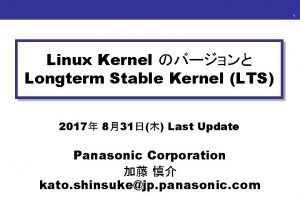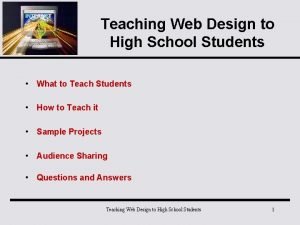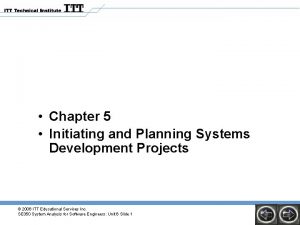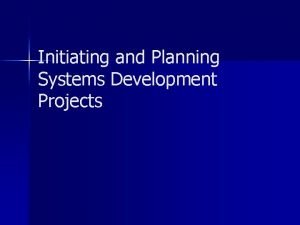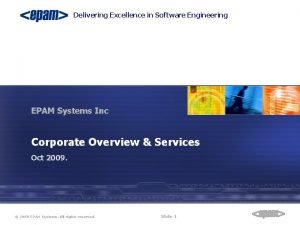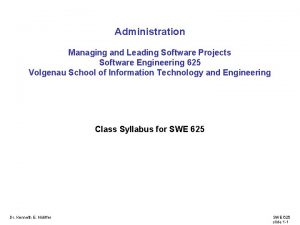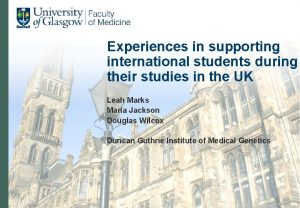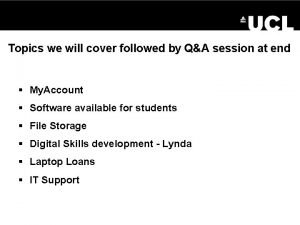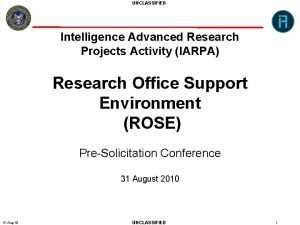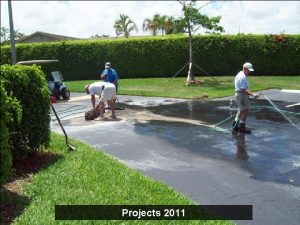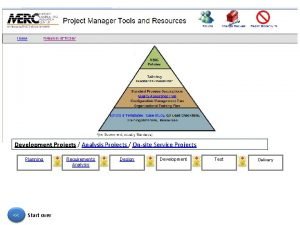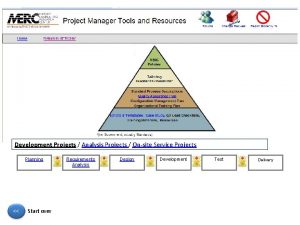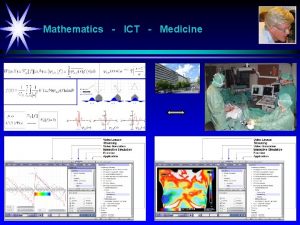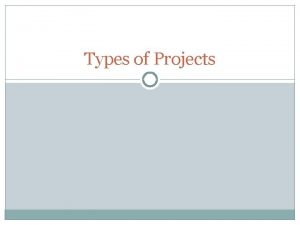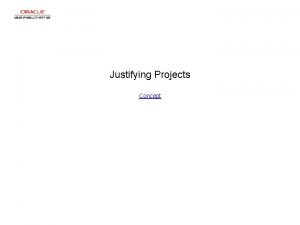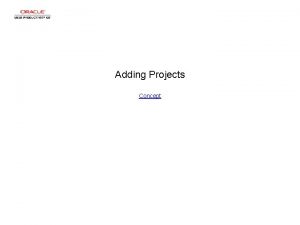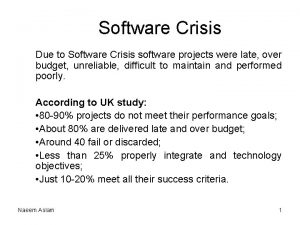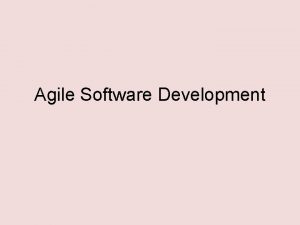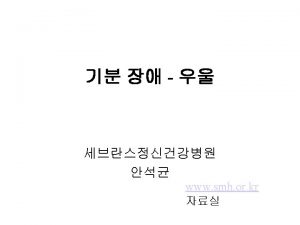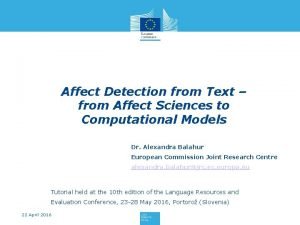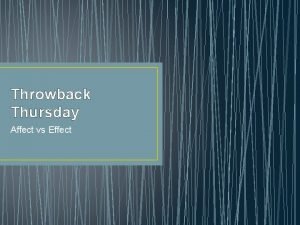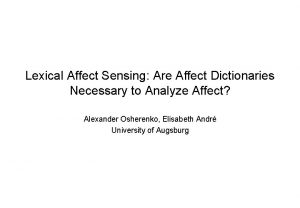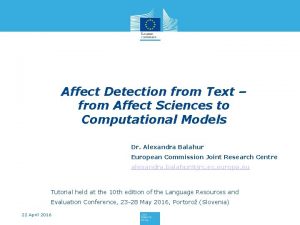LongTerm Software Projects Development The Affect of Students























































- Slides: 55

Long-Term Software Projects Development – The Affect of Students' Self-Appreciation and Initial Expectations Cecile Yehezkel Bruria Haberman Davidson Institute of Science Education Weizmann Institute of Science 1

Computer Science, Academia & Industry Educational Program for Establishing an Entry Point into the Computing Community of Practice 2

High School computing programs During the last two decades a program in computer science and a program in software engineering designed for the high-school level, have been in operation in Israel. With the aim: to expose young students to the fundamentals of computing and to motivate them to seek expertise in this field. (Gal-Ezer et al, 1995; Gal-Ezer & Harel, 1999; Haberman & Cohen, 2005) 3

• The programs have evolved over the years. • However, • There still exists a gap between school and the “real world” of computing: • Content • Learning style • professional norms 4

Motivation The existing gap motivated us to initiate the Computer Science, Academia and Industry extra-curricular educational program in the Davidson Institute of Science Education (Weizmann Institute of Science) 5

Goals To expose young students directly by leading experts to an up-to-date field of computing • • R&D processes. Common issues that professionals cope with. Advanced technologies and methodologies. Professional norms. 6

Our Vision Our program represents an initiative to establish a different "breaking out of the box learning space" in the sense that it enables students to: • Bridge the gap between school and the “real world” of computing • Experience a different learning style • Apply different learning and thinking skills 7

A new learning culture Traditional approach • Students should acquire explicit knowledge based on a thorough understanding of the topic learned. New approach • Students should be taught to employ a breadthoriented "tasting"-based learning style. • The initial exposure to an unfamiliar topic will be accomplished by getting acquainted only with its essence. 8

The program • (Stage A) - Enrichment meetings Breadth-oriented learning style • (Stage B) - Development of software projects • In a setting that simulates a "real world" environment • Depth-oriented learning style 9

The student population Excellence - a relative property • Stage A - 11 th grade students who major in CS/SE and who their teachers consider as "excellent students“ (relatively to their classmates). • As a result, there is a great diversity in the student population. • Stage B – 12 th grade students who exhibit the following characteristics: – High motivation, creativity, self-learning and inquiry ability – Persistence, consistency, ability to follow up a time table 10

Participation in the program % Grad. *** 52% 56% 61% Still working # Students # Schools Stage B ** Stage A* 25 71 9 Years 2004 -2006 50 140 20 2005 -2007 80 180 30 2006 -2008 85 210 30 2007 -2009 93 220 30 2009 -2010 Enrichment meetings ** Project development activity *** Students who successfully finished their project * 11

The program Stage A – Enrichment meetings – Students accompanied by their teachers, attend a 7 -month enrichment workshop. – Each meeting consists of a lecture by a CS/SE scientist, a lecture by a SE practitioner, and related class activities. – A "visiting the industry" tours are conducted. 12

Sample of topics • Advanced programming paradigms - scenario-based programming, aspect-based programming; • Development of complex systems - model-based development, advanced software development tools, computing in space; • Artificial intelligence - machine learning; neural networks, the control of motion in biological and robotic systems; • The synergy between computer sciences and biology – biological computers; modeling of biologic evolution; using computational models to comprehend behavior of biological systems; transmission of odor by a computer. • Professional norms - standards, the importance of 13 testing and controlled reuse of code;

Sample of activities • Construction and programming robots; • Challenging algorithmic problems; • Role-playing simulation games; • Creative thinking in computer science; • Model-based development; • Competition in testing software; 14

The program Stage B – Project development • Students develop projects under the apprenticeship-based supervision of professional mentors. – solving “real-world” problems for a real client – utilizing advanced industrial development tools • The school teachers are actively involved in supporting the students throughout the entire development process. 15

Recruiting leading experts We believe that the interaction of the students with leading representatives of communities of practice, who actually become role models for the students, may motivate them to pursue their studies further or pursue a career in the field. 16

• Project development experience under the supervision of professional experts may motivate students to acquire in-depth knowledge in computing, promote creativity, as well as enhance self-learning and inquiry ability. • The interaction with role models may contribute to establish professional norms. 17

Sample Projects Mentors from industry - practical characteristics • computerized homes; sun-heated water tank • programming a robot • managing a multimedia-shop • Antivirus Anti-worm Mentors from academia – theoretical, research-based • computerized graphics • image processing, voice recognition • automatic text categorization • modeling-based development of a control system • disassembling and reassembling DNA • simulation of theory of natural selection • games based on learning machine theory 18

Stage B Project development – The Process and Challenges 19

Phases of the project development activity Phase # Description Phase I Studying theoretical background needed for developing the project development Phase II Identifying the main algorithmic ideas Phase III Acquiring the needed technical knowledge - studying a suitable programming language and a development environment Phase IV Implementing the project (writing and testing the code) 20

The “Players” in the Project “CS, Academia and Industry” Program Centered at the Davidson Institute of Science Education The Mentor Barak Raveh, a 28 years old graduate research student specializing in applications of machine learning The Student Matan Peled, a 17 years old high-school student , selected according to personal skills and motivation High-School & Teacher A high School in an underprivileged Israeli town that specializes in students majoring in the sciences The challenge: productive cooperation between all four players 21

Employment Fair 22

The Employment Fare Simulation Students Personal Preferences Mutual interview Mentors List of Projects Final assignments of students to mentors aim to match personal preferences and skills of both student and mentor 23

Challenges Scientific Value Students are motivated if they believe their work has real value Mentor and Student Working Relations • Small gap of age can become an advantage • But the mentor lacks official authority and expertise Student Independence and Creativity Adhering to Professional Time-Tables Independence = essentiality of selfdiscipline by students 24

Project Design & Implementation A feedback loop between Mentor and Student Mentor provides student an initial framework for project Student comes up with his own ideas Mentor provides algorithmic knowledge and guidance to ideas of the student 25

Assessment The framework of the program is complex 31

Assessment • Many actors are involved: – Students, teachers, lecturers, mentors. • Diversity with respect to: – Students’ attitudes, preconceptions, norms, background and skills. – Mentor’s perception of the mentoring process. – Teacher’s perception of their roles. 32

A Long-Term Formative Evaluation of the Program We believe that in order to ensure that the students will benefit as much as possible from the program, it is important to cultivate collaboration and establish good communication between all the "players" (students, mentors, teachers, and the leading team). This can be fostered by accompanying the development of the program with a longterm formative evaluation while monitoring different processes that take place 33

A Long-Term Formative Evaluation of the Program The uniqueness of our evaluation model is its being naturally integrated as part of the program's operation, whereas the research tools serve as continuous "built-in" activities of the operational model. When evaluation is performed this way, the study subjects do not feel inconvenienced, 34

Evaluation - Goals To identify and analyze: 1. Expectations of newcomers. 2. Projects development processes. • Use of resources • Management 3. Students’ attitudes towards the “different-from-school” style of learning. (Yehezkel & Haberman, 2006; Haberman & Yehezkel, 2008; Haberman, Yehezkel & Salzer, 2009) 35

Project development 136 students (4 cycles) accomplished the development of comprehensive projects (~60%) One main drawback in the stage of project development is the high number of drop-outs. 36

Motivation The main goal was to find out: • How to better select candidates capable of accomplishing their projects • How to improve the mentoring model 37

Project development 1. Students’ motivation and initial expectations conducted on students of the 3 rd cycle (N=75) 38

Evaluation Candidates for project development (N=75) were given a questionnaire related to: – Initial motivation to develop a project; – Personal qualities considered valuable for developing a project; – Expected benefits; – Pre-assessment of the time needed for the project (hours per week). We compared the answers of two groups of students: those who accomplished their projects ("graduates") and those who 39

The questions (open) 1. Motivation: Why do I want do participate in stage B? 2. Aptitudes: Which qualities that I posses will help me to complete the project? 3. Expectations: What benefits can I expect from the project? 4. Pre-assessment of time needed for the 40

1. Why do I want do participate in stage B? Motivation Graduates Drop-outs Matriculation units 25% 23% Creativity 2% 13% Acquiring software development experience Knowledge enrichment 23% 10% 93% 97% Acquaintance with industrial proficiency 27% 23% Acquaintance with professionals (experts) Fondness of the domain 20 % 17% 20% 27% Self-satisfaction 7% 3% 41

Frequencies Motivation & Expectations 42

Frequencies for each item of aptitudes 43

Pre-assessment of time needed for the project • We found that the groups differed in their pre-assessment of time needed for the project (near to statistical significant difference) t-test, p=0. 06; Graduates: N=43 AVR=4. 64 SD=2. 54; Drop-outs: N=30 AVR=3. 60 SD=1. 91 • The findings indicated that the graduates had a more realistic appreciation of the time they will need to invest in their project. 44

Pre-assessment of time needed for the project 45

Evaluation 2. Analysis of projects development processes. Use of Resources conducted on students of the 2 nd cycle (N=28) 47

Students' assessment of resources • The students were asked to answer a reflective questionnaire just after submitting their final projects (N=28) a series of questions of that type: • When performing Phase # X, to what extent did you use the following resources? (high=5, low=1) 48

Resources • Bibliographic Resources • The Web, professional articles, professional books. • School • The school teacher, school learning (materials and methods). • Human Resources (Informal) • A classmate, a family member, a grown-up acquaintance. • Mentoring • The mentor. • Self-Studying • The student. 49

Students' assessment of resources used for project development 50

Students' assessment of resources used for project development 51

Findings • The students exhibited self-efficacy. • They relied more on themselves than on other resources especially toward the complete implementation of the project. • Low reliance on classmates their own age, and higher reliance on school learning. • The school teachers were low-appreciated but better appreciated than a family member and a grown-up acquaintance. • Self-studying and the web were perceived as the most significant resources. It may imply that the mentors' guidance inspired the students' self-inquiry and self-study. 52

Evaluation 2. Analysis of projects development processes. Management conducted on students of the 2 nd cycle (N=28) 55

Evaluation 3. Students’ attitudes towards the “different-from-school” style of learning. conducted on students of the 3 rd cycle (N=85) 63

Attitudes towards Stage A The students viewed the program as fulfilling their expectations. • They indicated that the program provides an acquaintance with up-to-date subjects. • They appreciated more the wide exposure to a variety of new subjects than focusing in-depth on one subject. • They rarely expected the program to focus more on subjects learned at school. 64

Attitudes towards Stage A • They highly appreciated the experience of meeting researchers and professionals in the field. • The program increased their motivation to pursue further studies of CS/SE and professional carriers in the field. • They were highly interested in participating again in enrichment workshop and were willing to recommend to their friends to participate in the program. 65

Triggering a new culture of learning • The students underwent a change on both a personal and a class level. • The teachers reported to us that new types of class activities were initiated by the attendees of the extra-curricular program. 67

Summary We hope that his program will trigger more representatives of academia and the high-tech industry to take an active part in educating potential newcomers and that way contribute to make the computing professional domain more attractive. 70

Summary We hope that our program will promote a culture of learning and work befitting the dynamic world of industrial computing and provide the students with an entry point into the computing community of practice. 71

Thank You 72

The Employment Fare 73
 Software projects for students
Software projects for students Linux kernel lts
Linux kernel lts Thomas silverstein
Thomas silverstein Web design projects for high school students
Web design projects for high school students Initiating and planning systems development projects
Initiating and planning systems development projects Project identification and selection process
Project identification and selection process Initiating and planning systems development projects
Initiating and planning systems development projects Rizal was involved in student demonstration in madrid
Rizal was involved in student demonstration in madrid Epam delivery centers
Epam delivery centers Managing and leading software projects
Managing and leading software projects Personal development plan for university students
Personal development plan for university students Ucl n drive
Ucl n drive Hình ảnh bộ gõ cơ thể búng tay
Hình ảnh bộ gõ cơ thể búng tay Bổ thể
Bổ thể Tỉ lệ cơ thể trẻ em
Tỉ lệ cơ thể trẻ em Gấu đi như thế nào
Gấu đi như thế nào Glasgow thang điểm
Glasgow thang điểm Bài hát chúa yêu trần thế alleluia
Bài hát chúa yêu trần thế alleluia Môn thể thao bắt đầu bằng từ chạy
Môn thể thao bắt đầu bằng từ chạy Thế nào là hệ số cao nhất
Thế nào là hệ số cao nhất Các châu lục và đại dương trên thế giới
Các châu lục và đại dương trên thế giới Công của trọng lực
Công của trọng lực Trời xanh đây là của chúng ta thể thơ
Trời xanh đây là của chúng ta thể thơ Mật thư tọa độ 5x5
Mật thư tọa độ 5x5 Làm thế nào để 102-1=99
Làm thế nào để 102-1=99 độ dài liên kết
độ dài liên kết Các châu lục và đại dương trên thế giới
Các châu lục và đại dương trên thế giới Thơ thất ngôn tứ tuyệt đường luật
Thơ thất ngôn tứ tuyệt đường luật Quá trình desamine hóa có thể tạo ra
Quá trình desamine hóa có thể tạo ra Một số thể thơ truyền thống
Một số thể thơ truyền thống Bàn tay mà dây bẩn
Bàn tay mà dây bẩn Vẽ hình chiếu vuông góc của vật thể sau
Vẽ hình chiếu vuông góc của vật thể sau Thế nào là sự mỏi cơ
Thế nào là sự mỏi cơ đặc điểm cơ thể của người tối cổ
đặc điểm cơ thể của người tối cổ V. c c
V. c c Vẽ hình chiếu đứng bằng cạnh của vật thể
Vẽ hình chiếu đứng bằng cạnh của vật thể Vẽ hình chiếu vuông góc của vật thể sau
Vẽ hình chiếu vuông góc của vật thể sau Thẻ vin
Thẻ vin đại từ thay thế
đại từ thay thế điện thế nghỉ
điện thế nghỉ Tư thế ngồi viết
Tư thế ngồi viết Diễn thế sinh thái là
Diễn thế sinh thái là Các loại đột biến cấu trúc nhiễm sắc thể
Các loại đột biến cấu trúc nhiễm sắc thể Các số nguyên tố là gì
Các số nguyên tố là gì Tư thế ngồi viết
Tư thế ngồi viết Lời thề hippocrates
Lời thề hippocrates Thiếu nhi thế giới liên hoan
Thiếu nhi thế giới liên hoan ưu thế lai là gì
ưu thế lai là gì Sự nuôi và dạy con của hươu
Sự nuôi và dạy con của hươu Sự nuôi và dạy con của hổ
Sự nuôi và dạy con của hổ Hệ hô hấp
Hệ hô hấp Từ ngữ thể hiện lòng nhân hậu
Từ ngữ thể hiện lòng nhân hậu Thế nào là mạng điện lắp đặt kiểu nổi
Thế nào là mạng điện lắp đặt kiểu nổi Optical illusions science fair project hypothesis
Optical illusions science fair project hypothesis Intelligence advanced research projects activity
Intelligence advanced research projects activity

